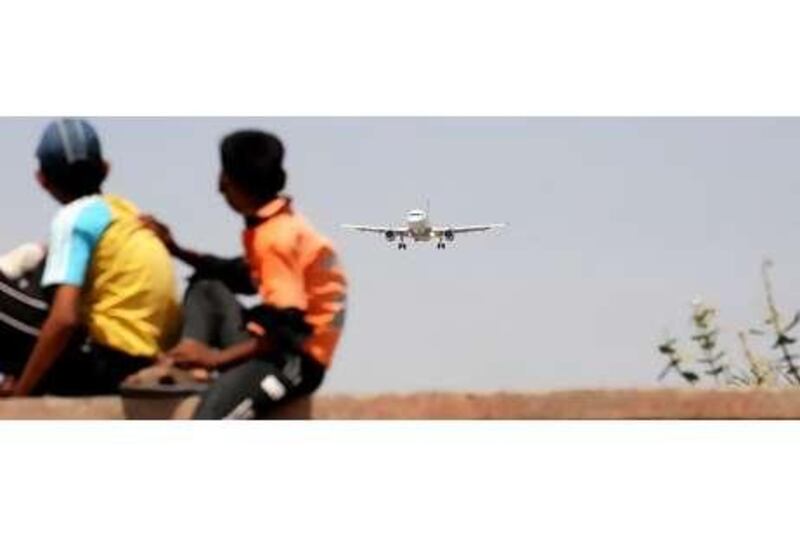MUMBAI // Two passenger aircraft narrowly missed a head-on collision at Mumbai's domestic airport this month, one in a number of recent incidents that underline growing concern about the country's aviation safety standards.
An air traffic controller ordered a Kingfisher Airlines plane, arriving from New Delhi with 270 passengers on board, to land on a runway where a Spice Jet plane with nearly the same number of passengers was parked. The Spice Jet aircraft, bound for Chennai, aborted takeoff at the last minute after it serendipitously detected a technical problem with its engine. The controller had asked Kingfisher Airlines to terminate landing seconds before final approach. The civil aviation ministry refused to comment on the incident, but in a statement said it had ordered an inquiry.
The incident, one of several close calls in recent months, highlights grave safety concerns plaguing India's aviation sector, which is currently expanding at a dizzying rate. India is poised to emerge as the world's fastest growing aviation market in the next decade, according to Airbus, the European aircraft manufacturer. As India's economy has grown in the past six years, air travel has nearly doubled as rising disposable incomes encourage people to shun trains to travel by air.
Domestic air traffic climbed to 35 million passengers at the end of the previous financial year from fewer than 15 million six years ago, according to the Centre for Asia Pacific Aviation, an independent aviation research group. Seven carriers operate 11 different airline brands in India compared to four airlines in 2003. The size of India's commercial aircraft fleet is expected to rise to more than 1,000 planes by 2028 from the current 380 planes. But aviation infrastructure has not kept pace with this meteoric growth, spawning serious safety concerns.
India's airports reported as many as 70 "near misses" in the last three years, according to Praful Patel, the minister for civil aviation. The reasons included "co-ordination failures" and stress and fatigue from heavy airport traffic, he told the Indian parliament in March. A number of additional near misses have been reported since then, adding to Mr Patel's tally. On May 31, a plane flown by Air India Express, a low-cost subsidiary of the state-owned national carrier, Air India, bound for Pune from Dubai, plummeted 5,000 feet after hitting an air pocket over Indian air space. The plane, with 112 passengers on board, was reportedly flying on the autopilot mode at the time, while the pilot was in the toilet and the co-pilot had passed out - for reasons still not known - with the cockpit door locked from the inside. The door was eventually opened and the pilot managed to land the plane safely, but not without some panicky moments.
The pilot left the cockpit even though the Director General of Civil Aviation, India's aviation regulator, issued a fresh directive to all airlines redefining correct landing procedures: a senior member of the cabin crew must be present in the cockpit in case one of the pilots has to leave. The airline has suspended the pilots and ordered an investigation. The incident came just weeks after an Air India plane crashed in Mangalore on May 22, claiming 158 lives. A new aircraft, operated by experienced pilots, overshot the runway on a table top landing strip, plunging down an embankment and bursting into flames. This was the worst air crash in India since the mid-air collision between a Saudi Airlines flight and a Kazakhstan Airlines plane in November 1996, killing 349 people.
An independent inquiry team is likely to submit a report on the causes of the Mangalore crash by August 31. But the recordings in the flight data recorder, or black box - which revealed that the captain ignored the co-pilot's plea to abort landing - indicate that pilot error could be the reason for the crash. Two of India's busiest airports, Mumbai and New Delhi, face an acute shortfall of air traffic controllers. About 100 controllers guide almost 500 planes a day, representing an almost 50 per cent shortfall, according to the Center for Asia Pacific Aviation.
Across 87 domestic airports, an inadequate 1,000 air traffic controllers guide 2,500 planes a day. As air traffic grows at an exponential pace, India needs a minimum of 2,500 air traffic controllers, experts say. Even among the existing staff, aviation experts say regulatory oversight of safety and crew and staff training standards across air traffic controls are poor. Asif Abdul Kadar, 35, the secretary of the All India Ex-Air Traffic Controllers Association, a support group for former air traffic controllers, said: "You cannot blame air traffic controllers for all problems. If it's a busy airport, controllers are under a lot of pressure. You calculate that a plane should take 30 seconds to be airborne, but the pilot takes a minute. It spoils the co-ordination between aircrafts and you make a fatal judgment."
Mr Kadar, a former air traffic controller for nine years at Calicut airport in Kerala state, blames a shortage of manpower, low wages and long work hours for the rising spate of "near misses". He said he quit his job for personal reasons in 2005. Unprofessional behaviour of crew and airlines also occasionally compromises safety. Media reports over the past few years have claimed incidents of pilots being drunk on duty are frequent.
Last year, the crew of an Air India flight was embroiled in a mid-air scuffle with each other half way through the flight, leaving the airplane unmanned for a few minutes. The crew was eventually suspended. achopra@thenational.ae





